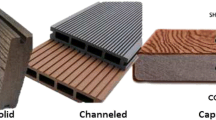Abstract
Research on the use of sustainable fillers which promote improvements in the paints has been reported over the years. The present study investigated the production and characterization of a biochar produced from Pinus elliottii for application in an epoxy paint cured by ultraviolet radiation, comparing it with graphite, in proportions of 12.5 and 20 wt%. The Pinus elliottii sample was initially ground, and then submitted to physical and morphological characterization by field emission scanning electron microscopy (SEM) and X-ray diffraction (XRD). Later, the Pinus elliottii sample was subjected to pyrolysis at a temperature of 1050°C at a low heating rate (5°C/min). Biochar and graphite were separately incorporated into an epoxy UV-curable paint. The painted samples had their thickness measured and their mechanical and physical properties evaluated, namely gloss, hardness, bending, impact, contact angle with water, and exposure to salt spray. Biochar and graphite promoted a reduction in gloss and improved pencil hardness when incorporated into a UV-curable epoxy paint. In the salt spray resistance test, samples containing both biochar and graphite showed a slight delay in the beginning of the corrosion process. However, samples with biochar behaved better than samples with graphite in terms of blistering of the film in the incision region.
















Similar content being viewed by others
References
Giorcelli, M, Savi, P, Khan, A, Tagliaferro, A, “Analysis of Biochar with Different Pyrolysis Temperatures Used as Filler in Epoxy Resin Composites.” Biomass Bioenergy, 122 466–471. https://doi.org/10.1016/j.biombioe.2019.01.007 (2019)
Basu, P, Biomass Gasification and Pyrolysis. Elsevier, Amsterdam. https://doi.org/10.1016/C2009-0-20099-7 (2010)
Muhlack, RA, Potumarthi, R, Jeffery, DW, “Sustainable Wineries Through Waste Valorisation: A Review of Grape Marc Utilisation for Value-Added Products.” Waste Manag., 72 99–118. https://doi.org/10.1016/j.wasman.2017.11.011 (2018)
Haykiri-Acma, H, Yaman, S, Kucukbayrak, S, “Gasification of Biomass Chars in Steam-Nitrogen Mixture.” Energy Convers. Manag., 47 1004–1013. https://doi.org/10.1016/j.enconman.2005.06.003 (2006)
Zhang, P, Tang, J, Tang, Q, Zhang, M, Shen, L, Tian, W, Zhang, Y, Sun, Z, “Shell Powder as a Novel Bio-filler for Thermal Insulation Coatings, Chinese.” J. Chem. Eng., 27 452–458. https://doi.org/10.1016/j.cjche.2018.02.006 (2019)
Kaboorani, A, Auclair, N, Riedl, B, Landry, V, “Physical and Morphological Properties of UV-Cured Cellulose Nanocrystal (CNC) Based Nanocomposite Coatings for Wood Furniture.” Prog. Org. Coat., 93 17–22. https://doi.org/10.1016/j.porgcoat.2015.12.009 (2016)
Yew, MC, Ramli Sulong, NH, Yew, MK, Amalina, MA, Johan, MR, “Eggshells: A Novel Bio-filler for Intumescent Flame-Retardant Coatings.” Prog. Org. Coat., 81 116–124. https://doi.org/10.1016/j.porgcoat.2015.01.003 (2015)
Piazza, D, Silveira, DS, Lorandi, NP, Birriel, EJ, Scienza, LC, Zattera, AJ, “Polyester-Based Powder Coatings with Montmorillonite Nanoparticles Applied on Carbon Steel.” Prog. Org. Coat., 73 42–46. https://doi.org/10.1016/j.porgcoat.2011.08.018 (2012)
Rawat, RS, Chouhan, N, Talwar, M, Diwan, RK, Tyagi, AK, “UV Coatings for Wooden Surfaces.” Prog. Org. Coat., 135 490–495. https://doi.org/10.1016/j.porgcoat.2019.06.051 (2019)
Ferreira, SD, Lazzarotto, IP, Junges, J, Manera, C, Godinho, M, Osório, E, “Steam Gasification of Biochar Derived from Elephant Grass Pyrolysis in a Screw Reactor.” Energy Convers. Manag., 153 163–174. https://doi.org/10.1016/j.enconman.2017.10.006 (2017)
Weber, K, Quicker, P, “Properties of Biochar.” Fuel, 217 240–261. https://doi.org/10.1016/j.fuel.2017.12.054 (2018)
Debiagi, PEA, Gentile, G, Cuoci, A, Frassoldati, A, Ranzi, E, Faravelli, T, “Yield, Composition and Active Surface Area of Char from Biomass Pyrolysis.” Chem. Eng. Trans., 65 97–102. https://doi.org/10.3303/CET1865017 (2018)
Zazycki, MA, Godinho, M, Perondi, D, Foletto, EL, Collazzo, GC, Dotto, GL, “New Biochar from Pecan Nutshells as an Alternative Adsorbent for Removing Reactive Red 141 from Aqueous Solutions.” J. Clean. Prod., 171 57–65. https://doi.org/10.1016/j.jclepro.2017.10.007 (2018)
Ferreira, SD, Altafini, CR, Perondi, D, Godinho, M, “Pyrolysis of Medium Density Fiberboard (MDF) Wastes in a Screw Reactor.” Energy Convers. Manag., 92 223–233. https://doi.org/10.1016/j.enconman.2014.12.032 (2015)
Abdullah, H, Wu, H, “Biochar as a Fuel: 1. Properties and Grindability of Biochars Produced from the Pyrolysis of Mallee Wood Under Slow-Heating Conditions.” Energy Fuels., 23 4174–4181. https://doi.org/10.1021/ef900494t (2009)
Kaboorani, A, Riedl, B, “Surface Modification of Cellulose Nanocrystals (CNC) by a Cationic Surfactant.” Ind. Crops Prod., 65 45–55. https://doi.org/10.1016/j.indcrop.2014.11.027 (2015)
Sofla, MRK, Brown, RJ, Tsuzuki, T, Rainey, TJ, “A Comparison of Cellulose Nanocrystals and Cellulose Nanofibres Extracted from Bagasse using Acid and Ball Milling Methods.” Adv. Nat. Sci. Nanosci. Nanotechnol., 7 035004. https://doi.org/10.1088/2043-6262/7/3/035004 (2016)
Kim, KH, Kim, JY, Cho, TS, Choi, JW, “Influence of Pyrolysis Temperature on Physicochemical Properties of Biochar Obtained from the Fast Pyrolysis of Pitch Pine (Pinus rigida).” Bioresour. Technol., 118 158–162. https://doi.org/10.1016/j.biortech.2012.04.094 (2012)
Idrees, M, Jeelani, S, Rangari, V, “Three-Dimensional-Printed Sustainable Biochar-Recycled PET Composites.” ACS Sustain. Chem. Eng., 6 13940–13948. https://doi.org/10.1021/acssuschemeng.8b02283 (2018)
Perry, RH, Green, DW, Maloney, JO, Perry’s Chemical Engineer’s Handbook, 7th edn. McGraw-Hill, New York (1997)
Wong, JWC, Webber, JBW, Ogbonnaya, UO, “Characteristics of Biochar Porosity by NMR and Study of Ammonium Ion Adsorption.” J. Anal. Appl. Pyrolysis., 143 104687. https://doi.org/10.1016/j.jaap.2019.104687 (2019)
Author information
Authors and Affiliations
Corresponding author
Additional information
Publisher's Note
Springer Nature remains neutral with regard to jurisdictional claims in published maps and institutional affiliations.
Rights and permissions
Springer Nature or its licensor holds exclusive rights to this article under a publishing agreement with the author(s) or other rightsholder(s); author self-archiving of the accepted manuscript version of this article is solely governed by the terms of such publishing agreement and applicable law.
About this article
Cite this article
Marchesini, J., Perondi, D., Marocco, M.V. et al. Production and application of biochar in a UV radiation-curable epoxy paint as a substitute for graphite. J Coat Technol Res 20, 957–971 (2023). https://doi.org/10.1007/s11998-022-00715-w
Received:
Revised:
Accepted:
Published:
Issue Date:
DOI: https://doi.org/10.1007/s11998-022-00715-w




